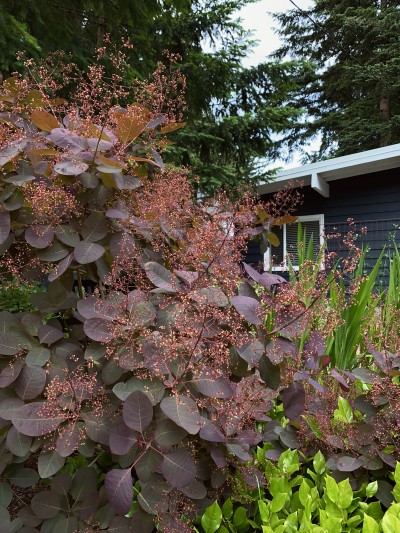
In the Northwest corner of the property, it anchors the front yard.
Overstory
This more than any other plant set in motion the complete transformation of our front-yard. Planted a year after moving in, it was placed in the NW corner of our lawn, which was nothing more than grass, a small patch of salal, and a few neglected yucca plants. It’s hard to think of many planting and design decisions that haven’t stemmed from the placement of this tree.
My wife and I chose it together, because we both loved the look of smoke trees, though we had no personal connection to them. Years later, I still clearly remember searching online for reference images, seeing how intriguing a gnarled smoke tree looked when mature, or how youthful a shrubby (likely coppiced) version seemed on New York’s High Line.
We planned for it to be tall, and it has grown about a foot each year, becoming a real presence on the property. It’s a mysterious tree, with unpredictable growth and leaves that change color almost daily. The shades of pink in late fall are almost neon and photos will rarely do it justice.
Details
Origin
Hybrid. There’s an American smoke tree (Cotinus obovatus) from the South, and this is a cross of that with a European smoke tree (Cotinus coggygria ‘Velvet Cloak’). — Purchased as a small 1-gallon container from a nursery in 2015.
Size
They grow into large trees unless coppiced every year, which creates a lush shrub but no flowers. We were going for a 20′+ tree, full of smokey flowers, to anchor the front-yard. Because of that, I’ve barely pruned it. — In year six, I removed a few long branches that were hovering over the ground.
Benefits
This was purchased purely for its aesthetic value. — I’ve observed crab spiders that when white, practically glow on the purple leaves. — Once the flowers bloomed in numbers, after five years, I was happy to see them visited by a variety of bees (late spring/early summer).
Family
Anacardiaceae
Relatives in the Yard
None listed (yet)



